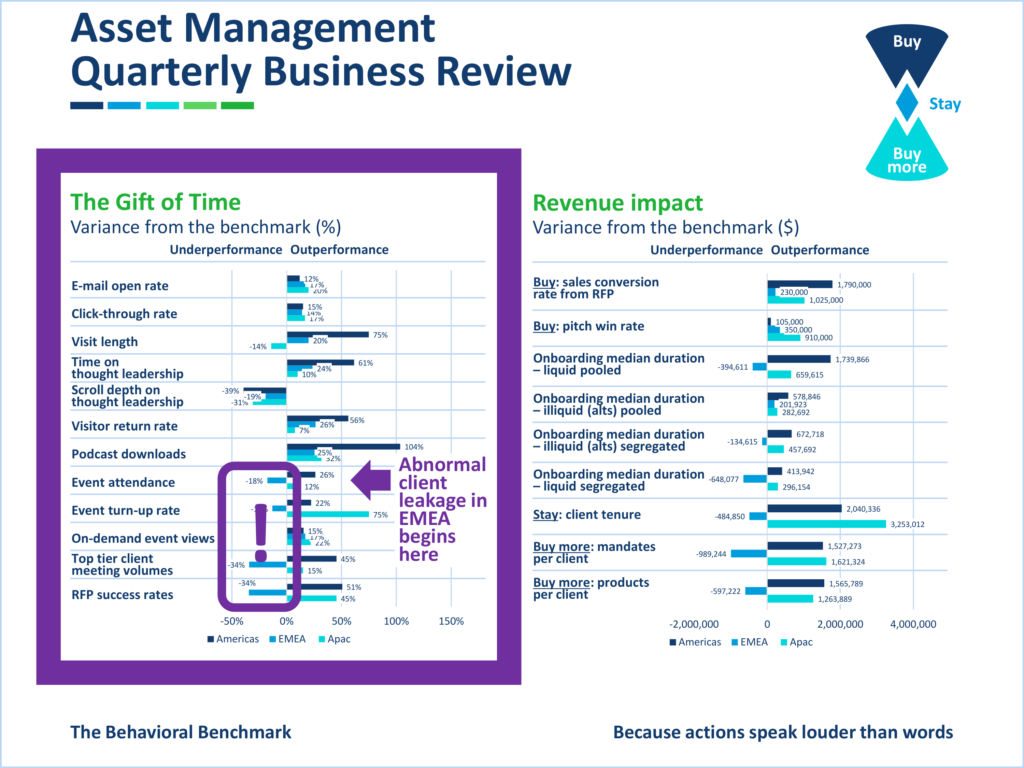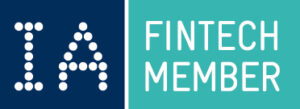In brief
In this article, we explain how time is your client’s most precious commodity, how you can use the Client Behavior Benchmark’s new Gift of Time functionality to pinpoint asset management client leakage, and how this will help you keep your sales funnel as wide as possible for as long as possible.
In combination with the recent addition of quantifiable revenue impacts, the Gift of Time completes the benchmark’s contribution to asset managers’ quarterly business reviews.
Welcome to this blog series on the new use cases that arose when the Client Behavior Benchmark extended its time series into its third year. Other use cases in the series include quantifying the revenue impacts of the behaviors you stimulate in clients, embedding client behaviors into your targets and QBRs, and responding quickly to changes in client behavior.
Time is your client’s most precious commodity
Time is every human’s most precious commodity. It is both free and priceless. You can spend it, but you cannot store it. And once you have used it, you cannot get it back.
Because of this, we guard our time jealously: we favour the summary notes over the full article, we bounce off websites after only a few seconds, and we leave things unfinished for ‘lack of time’. Positively, however, the things we give more time to are leading indicators because we give more to those we expect or want to play a part in our future.
Therefore, if you are an asset manager who wants to play a part in a client’s future, you need them to give more time to you than to your competitors. If they gave you no time, you didn’t stand out for them. If they gave you some time but not as much as they gave to a competitor, while it may have felt like they were hot for you, they were actually hotter for someone else.
Use time to pinpoint asset management client leakage
Although every action takes time, they are not all equal. Some are smaller, like opening an email; while others are bigger, like requesting a meeting. Some are virtual and private, like browsing your website; while others are in-person and public, like attending an event.
When you arrange the actions you want clients to take in order of the time they take, you get a sales funnel of client behaviors that covers your client-facing functions.
If you also compare the time clients gave to you versus other asset managers, you discover where and to what extent you stood out for your clients. This gives you a dashboard of out- and underperformance.
Where you outperformed, you kept your sales funnel wider than the others and, where you underperformed, more clients ‘leaked out’ compared to the average. This is the source of the new use case: pinpointing asset management client leakage.
All sales funnels leak, but if you know where it happens and can pinpoint any abnormal leakage, you can rectify problems, keep your sales funnel as wide as possible for as long as possible, and provide a differentiated experience for your clients.
Introducing the Gift of Time

“You [Accomplish] have a really cool dataset – it’s basically out- and underperformance across ‘the everything else’.”
A senior manager whose firm just signed up for their third consecutive year in the Client Behavior Benchmark.
The good news is that the functionality described above exists, and firms are already using it to gain advantage. The data in the image above is real, albeit a desensitized composite from multiple firms.
We did this to create a demo scenario in which clients of the EMEA business are doing nothing abnormal compared to those of the other regions until they ‘cross the rubicon’ from virtual to in-person behaviors. At the point between podcasts and event attendance, European clients start to give the firm less time compared to the Americas and Apac business units as well as external competitors: event attendance underperform, as do meeting volumes, and RFP success rates.
In trials, the Gift of Time tool performed exactly as expected: it helped practitioners demonstrate the results of recent email marketing initiatives, encouraged two digital teams to share lessons to bridge regional differences in performance, and validated an event strategy designed to stimulate the most follow-up meetings rather than just the highest attendees. Each of these examples resulted in outperformance that, therefore, kept the firm’s sales funnel wider compared to both the average and to what it would have otherwise been.
The gift that keeps on giving!
Learn and improve at stimulating behaviors – in terms of additional benefits of being able to pinpoint asset management client leakage, the first is obvious: because every human can stimulate behavior in others, your teams can learn and improve at this important skill.
A coherent strategy that demolishes siloes – second, looking at behaviors across an Hourglass-shaped sales funnel emphasises coherent multi-team strategies that prioritize the end over the means. For example, the events team above that targeted below-average event sizes so clients would have a greater chance of interacting with relationship managers and scheduling follow-on meetings. Demolish those siloes!
Prove ROI – third, ROI should be on everyone’s priority list, but is it possible for digital teams to calculate this without also knowing if their firm outperformed at stimulating dollarizable client behaviors, like buying, staying, and buying more? If you want to prove ROI, add this data to the Client Behavior Benchmark too.
Fine-tune your contact scoring – the fourth benefit relates to contact scoring where the Gift of Time implies that knowing your hottest contacts is not the same as them as them being hot for you. Direct industry benchmarks of out- and underperformance for behaviors like email opens and clicks, web visit length, event attendance etc will fine-tune your weightings and, if necessary, stimulate you to do more wherever it may be needed.
Targeted retention strategies – fifth and last, the opposite of hot is cold, so as well as calibrating when prospects are hot you can also see if an existing client’s interest cools – essential input information for a client retention strategy.
We hope you found this blog useful and that you can see how the Client Behavior Benchmark helps asset managers track their effect not just on whether clients give their money but also now their time.
If you enjoyed it, check out the other use cases on quantifying the revenue impacts of the behaviors you stimulate in clients, embedding client behaviors into your targets and QBRs, and responding quickly to changes in client behavior.
Or head to the Client Behavior Benchmark page to book a demo.



